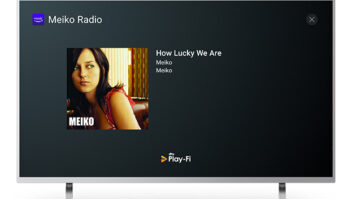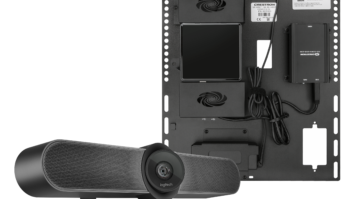As a news junkie, there is no more exciting night than a presidential or mid-term election year, when the pundits stay up all night reporting in the results from around the country. It used to be that we were dependant on the major networks, but now there are a seemingly infinite variety of information sources from which to get your politics fix. Switching channels, surfing the web, and watching streaming content all at the same time is challenging, particularly for those who simply want to sit in the same room and find out who won.
Thus, what better time to test out Logitech’s new Revue to see how well it integrates web and streaming content on a single screen?

For the average consumer, Logitech and GoogleTV’s Revue box works quite well for its intended purpose of melding the web and off-air, “cable,” and “pay” program content
GoogleTV as productized in the Revue, is a web browser, programmable remote control, and program guide all rolled into one. It has no tuners or on-board storage, but it does require a network connection where you have a choice of wired or 802.11 a/b/g/n on-board wireless. It comes with an RF wireless keyboard with built-in mouse pad and additional buttons specific to the tasks at hand as well as an IR blaster to transmit control codes to a system’s source components, an AVR or surround processor, and your display. Optional are a web cam that integrates video-chat into the range of available applications and a smaller, handheld remote with a mini-keyboard.
Set-up Specifics
Out of the box, setup and system integration is reasonably straightforward, though there are some things for the ESC to be aware of. Physical connections include an HDMI input if a cable or satellite set-top is the source, and an HDMI feed out to the AVR or directly to a display. The HDMI input is quoted as being v.1.3a, so caution is urged when an upstream source is delivering 3D content. For 3D with the over/under or side-by-side techniques used by cable and satellite, you may find that the signals will pass through, and you’ll be able to switch to the proper 3D format in the display with some sort of macro in a more sophisticated control system. Or, perhaps not.
In my test-bed setting of a typical family room where some of the components were behind doors, there was no problem in putting the IR blaster atop the Revue and simply point it out into the room. In a grand-scale home theater where components are hidden, the presence of two IR outputs lets you plan on whether or not to use the supplied blaster or individual on-device IR repeaters.
Power is supplied from a typical “wall wart” external supply, and the two USB jacks are mounted on the rear of the unit, so that should be taken into consideration if the Revue is to be used for local audio or still image playback. There is an optical jack for digital audio, though I suspect most custom installations will transport the audio through the HDMI link. The RJ-45 for 10/100 Base-T network connectivity rounds out the connections when wireless is not used and the power on/off switch is on the rear panel. This is worth noting for “green” considerations; there is no on/off for the unit on the front panel or the remote.
Setup took less than 10 minutes, though it is worth noting that a Google G-Mail account is required. Other than that, it’s the standard list of questions concerning the geographical location and service provider so that the proper channel listings are used and the list of devices to be controlled. To assure proper control, you’ll need to have the model number of the set-top, the display, and the AVR or processor, if the Revue’s remote is going to control them.
Wireless Keyboard as Control Center
In actual use, the lightweight, but full-sized keyboard becomes the control center, using either the keyboard itself, specific transport control functions, the mouse pad, or a few dedicated buttons at the top of the unit. It took a bit of time to get the hang of which button does what in my test setup, using a TiVoHD as the source, an AVR in the middle, and an LG LCD as the display.
It also takes a little getting used to moving down through a website with the navigation/directional “arrow” buttons, not by the familiar pattern of grabbing a scroll bar with the cursor and scrolling down. Putting that, alone, on a client instruction card could save you service calls.

Revue comes with an RF wireless keyboard with built-in mouse pad and additional buttons specific to the tasks at hand as well as an IR blaster to transmit control codes to a system’s source components, an AVR or surround processor, and your display.
GoogleTV’s Power Becomes Evident
On election night we were able to use the PIP function to put live video down in the lower right corner while surfing the web or leaving a static web page up in the main screen to watch results. The same idea was used by our resident sports fan to watch one game in the PIP window, while following the “Stadium View” of his own university’s game on the main screen, refreshing every 30 seconds just as it would on a laptop, smart phone or iPad. The advantage here was the integration and being able to see it on one screen instead of shifting focus from the “10-foot screen” to the “10-inch” screen.”
Even in normal viewing situations, using the GoogleTV search functions with the browser meshed well when search results pointed to program my family wanted to view or record. There were no channel line-up misses, and a search could take us to a website, to a choice of viewing options, and whether we wanted to view a currently available show or record one that is yet to air. Bravo to Revue and GoogleTV for getting that key bit of functionality right.
Other high-points were seamless remote integration, as one would expect from Logitech thanks to the extensive database of remote codes developed for its Harmony product line. A miss, however, was that while there were power buttons for “AVR”, “TV” and “STB”, there was no provision for turning off our AVR. Like many, it has the discreet on and off commands installers prefer rather than the on/off toggle used by set-tops and most TVs. In our case, pressing the button would turn the AVR on, but you had to go to the AVRs remote to turn it off. Hopefully, the power buttons will be programmable in future iterations. One thing you can’t do, however, is program the keyboard commands for the Revue into another control system. The keyboard is RF, and there really isn’t any way to replicate the commands for use by another device.
Will Clients Like the Interface?
For the average consumer, the Revue works quite well for its intended purpose of melding the web and off-air, “cable,” and “pay” program content. It does that, as well, for the custom world, bring one of the better implementations I’ve seen for YouTube on a consumer device as well as the obligatory access to Netflix, Pandora, a “CNBC Real Time” channel, and a number of other movie, news, entertainment and informational services. You can also access content from other devices on the home’s network, though that alone is no longer a unique feature. The true test of whether or not this is something that appeals to a specific client is whether or not they are comfortable with the interface and integration. For that reason we recommend that this is perhaps a product you may want to put in your demo system first.
Constructive Criticism
As with any product, particularly one as new as Revue/GoogleTV, there were a number of things that some might find problematic. I point them out here as some can be fixed in the device while others might be solved with workarounds. For example, when switching to the Revue our display showed a “white snow screen” rather than the typical black screen during what we presume was the HDMI/HDCP handshake. This is something you’ll want to point out to consumers as “don’t worry, it’s normal.”
Similarly, you’ll want to look closely to see if any adjustment is required to the lip sync delay in your AVR or surround processor, as I had to add a little to compensate for some slight slip.
Also, in at least in the initial implementation of Revue, the PIP window can only be called up when you are watching incoming video and want to reduce that image down to view a web page in the main screen, but you can’t do it the other way around. In other words, you can’t see something on a web page and then press the PIP button to view incoming video.
One area where the use of the browser and incoming video collide is when you have a PIP window for video and click to watch streaming content from a website. The good news is that the Chrome browser is compatible with most, if not all, of the popular technologies used for streaming playback. We could watch videos from the news and sports sites with no problem. However, when playing streaming content with the PIP engaged, there was no way to mute the audio from the PIP source to listen only to the streaming source. Revue does not work in the same way as the PIP system you may be used to in a TV where the audio follows the “larger” source. Here, it always follows the incoming video. You can, however, listen to the incoming audio only and mute the streaming video’s sound by using the commands in the player for that stream in the browser window.
Speaking of audio, the audio output from the Revue is always PCM. That’s not a problem and the audio quality was fine. However, because the audio output of the TiVo is Dolby Digital bitstream, at first I thought that there was something wrong when I saw the “PCM” indication of audio input on the AVR.
What’s Ahead
One thing that we will certainly see, probably some time in the first half of 2011 is access to the Android App market. It’s too early to know what applications will be offered either by Google, Logitech or third-party developers, but the prospect of a growing new market into which they can all sell “apps” on a product that brings content to a consumer’s “big screen,” rather than their phone or a tablet should prove enticing to those in the content world.





